| |
Click on the maps for larger image |
| |
|
| Regional Surface Meteorological Networks |
| |
|
| WMAR WeatherNet
- WMAR-TV in Baltimore, Maryland operates this network of 131 stations located
primarily at schools throughout Maryland, eastern Pennsylvania, and Delaware
(126 in Maryland). The
network provides up to 1-minute observations of air temperature, relative
humidity, wind speed, wind direction, precipitation, and barometric pressure.
For further information visit the
WMAR
network page. |
No map yet. |
| |
|
| WCAU SchoolNet - WCAU-TV in
Philadelphia, Pennsylvania operates this network of 230 stations located at
schools throughout Pennsylvania and surrounding states (1 in Maryland). The network provides up to 1-minute
observations of air temperature, relative humidity, wind speed, wind direction,
precipitation, and barometric pressure. For further information visit the
WCAU network page. |
No map yet. |
| |
|
| WPXI SchoolNet - WPXI-TV in
Pittsburgh, Pennsylvania operates this network of 63 stations located at
schools throughout Pennsylvania and surrounding states (2 in Maryland). The network provides up to 1-minute
observations of air temperature, relative humidity, wind speed, wind direction,
precipitation, and barometric pressure. For further information visit the
WPXI network page. |
No map yet. |
| |
|
| State and Local Surface Meteorological Networks |
| |
|
| Maryland Department of Transportation
(DOT) Road Weather Information System (RWIS) Network - The Maryland DOT
operates this network of 45 stations with locations along highways throughout the
state of Maryland. The network provides variable (hourly or higher) resolution
observations of air temperature, dew point, relative humidity, and wind speed.
For further information visit the
Maryland DOT RIWS page or the
Surface Systems, Inc Road
Weather page. |
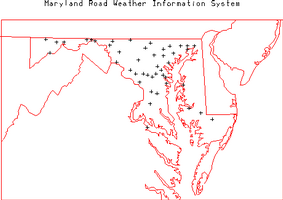 |
| |
|
| Aberdeen Proving Ground Network
- The US Army operates the Abderdeen Proving Ground network of 5 station with
locations to the northeast of Baltimore, Maryland. The data from this network
is included in the
NOAA/FSL MADIS data set. |
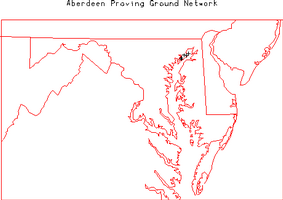 |
| |
|
| Precipitation and Radar Networks |
|
|
| Community Collaborative Rain, Hail and Snow Network (CoCoRaHS) - The Colorado
Climate Center at Colorado State University overseas this cooperative network of observers
located throughout Maryland. The network provides daily observations of
precipitation, snowfall, and snow depth. Hailpad observations are also made at many
locations. For further information visit the
CoCoRaHS home page. |
No map. |
| |
|
| NOAA/National Centers for Environmental
Prediction (NCEP) Hourly Precipitation Data - NOAA/NCEP routinely develops
a National Multi-sensor Hourly Precipitation Analysis (Stage II) data set from
hourly radar precipitation estimates and from hourly gage reports. The gage data
includes hourly observations from ~4000 gages across the US (12 in Maryland)
collected by the NOAA River Forecast Centers and sent to NCEP. Further information
on these data is available at:
http://wwwt.emc.ncep.noaa.gov/mmb/ylin/pcpanl/. |
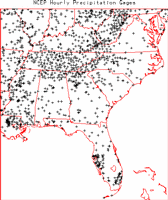 |
| |
|
| NOAA/NWS Cooperative Observer 15-minute Precipitation Network - The NOAA/NWS
routinely collects 15-minute observations of precipitation from Fisher-Porter and Universal
rain gages operated by 2777 cooperative observers located throughout the US (18 in Maryland).
These data are archived at NOAA/NCDC as data set TD 3260. For further information visit the
NOAA/NCDC TD3260 page. |
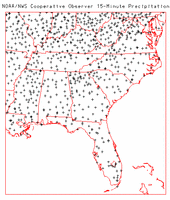 |
| |
|
| Integrated FLood Observing and Warning System
(IFLOWS) Precipitation Network - The IFLOWS precipitation network is a collection
of various state operated Automated Flood Warning System (AFWS) networks throughout
the mid-Atlantic and northeastern portions of the United States. The network is
comprised of 1530 precipitation stations that provide 15-minute observations of
precipitation (73 in Maryland). These precipitation data are included as part of the NCEP
Precipitation data set described above. For further information visit the
AFWS home page. |
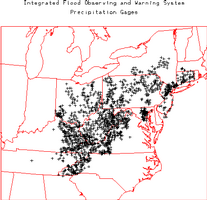 |
| |
|
| Radiation and Flux Networks |
| |
|
| Environmental Protection Agency (EPA) Ultraviolet
Monitoring Program (UV-Net) - The EPA operates this network of 20 Brewer
spectrophotometers throughout the US (1 in Maryland). The network provides observations of
full-sky spectrally resolved solar radiation in the UV-B and UV-A bands. The
irradiance and total column ozone concentrations are derived from these data.
For further information visit the
EPA UV-Net page. |
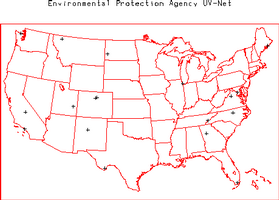 |
| |
|
| United States Department of Agriculture (USDA)
UV-B Monitoring Network - The USDA operates this network of 29 stations
with locations throughout the US (2 in Maryland). The network provides
3-minute observations of spectral total/direct/diffuse radiation, air temperature,
relative humidity, solar radiation, barometric pressure, and photosynthetically
active radiation. For further information visit the
USDA UV-B Monitoring page. |
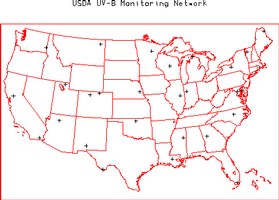 |
| |
|
| Ameriflux Network - The Ameriflux network consists of 50 sites conducting
long-term measurements of CO2, water and energy fluxes throughout the US (1 in Maryland).
The typical observational frequency is 30 minutes. The parameters measured at each site
vary, but Ameriflux has defined a core set of parameters that most sites collect, including
fluxes of CO2, energy and water, basic meteorological and radiation parameters, and soil
temperature and moisture. For further information visit the Ameriflux home page at:
http://public.ornl.gov/ameriflux/Participants/Sites/Map/index.cfm. |
 |
| |
|
| Soil Networks |
| |
|
| Soil Climate Analysis Network (SCAN) - The SCAN is operated by the United
States Department of Agriculture (USDA) Natural Resources Conservation Service (NRCS). The
network provides hourly observations of air temperature, relative humidity, wind speed,
wind direction, solar radiation, precipitation, barometric pressure, snow water content,
snow depth, soil temperature (at 2, 4, 8, 20, and 40 cm depths), and soil moisture (at 2, 4,
8, 20 and 40 cm depths). The 80 SCAN stations are located across the US in primarily
agricultural regions (1 in Maryland). For further information visit the
SCAN home page. |
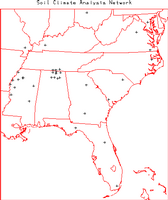 |
| |
|
| Hydrology Networks |
| |
|
| United States Geological Survey (USGS) Streamflow
Network - The USGS (part of the US Department of the Interior) operates this
network of 7237 streamflow gages (60 in Maryland) at locations throughout the US.
The network provides hourly or more frequent observations of stage (water level) from
which discharge (flow) is comuputed using a stage-discharge rating relation. The
rating is defined by occasional direct current-meter measurements of discharge. All
data are available through the USGS and the district offices in each state. Many of
these gages provide realtime data
relayed via the GOES satellite data collection system. The realtime data are
provisional data that have not been reviewed or edited. These realtime data
may be subject to significant change and are not citeable until reviewed and approved
by the USGS. Realtime data may be changed after review because the stage-discharge
relationship may have been affected by: 1) backwater from ice or debris; 2) algal and
aquatic growth in the stream; 3) sediment movement; and 4) malfunction of recording
equipment. Each station record is considered provisional until the data are
published. The data are usually published with 6 months of the end of the water year
(1 October to 30 September). Data users are cautioned to consider carefully the
provisional nature of the information before using it. For further information on the
USGS stremflow network visit the
USGS Water Resources of the United
States page or the
USGS Maryland District Office
home page. |
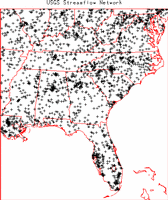 |
| |
|
| Integrated FLood Observing and Warning System
(IFLOWS) Streamflow Network - The IFLOWS network is a collection of various
state operated Automated Flood Warning System (AFWS) networks throughout the mid-Atlantic
and northeastern portions of the United States. The network is comprised of 275
streamflow gages that provide 15-min stage observations (25 in Maryland). For
further information visit the
AFWS home page. |
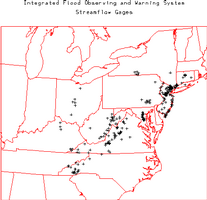 |
| |
|
| USDA/ARS Watershed Research - The USDA/ARS operates a number of
research watersheds throughout the US. Some of the best instrumented include the
Reynolds Creek in Idaho, the Walnut Gulch in Arizona, the Southern Plains
Experimental Range in Oklahoma, the Little Washita River in Oklahoma, the Blackland
Prairie in Texas, the Goodwater Creek in Missouri, the Walnut Creek in Iowa,
Goodwin Creek in Mississippi, the Little River in Georgia, the Oconee River in
Georgia, the North Appalachian Watershed in Ohio, the National Agriculture Research
Center in Maryland, and the Mahantango Creek in Pennsylvania. Most of these have at
least one surface meteorological station and a precipitation gage network. For
further information visit the USDA/ARS Watershed Research home page at:
http:/www.nwrc.ars.usda.gov/watershed/. |
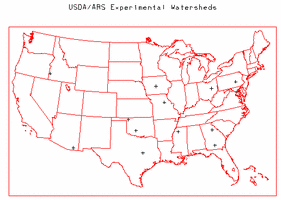 |
| |
|
| Upper Air Networks |
|
|
| NOAA/NWS Radiosonde Network Low Vertical Resolution Data - The NOAA/NWS
typically releases radiosondes twice per day at 0000 and 1200 UTC at 69 locations throughout
the US (1 in Maryland). During special weather situations the NWS can request to release
additional radiosondes at off-times (e.g. 1800 UTC). The low resolution data is sent out
over the Global Telecommunications System (GTS) and provides mandatory and significant level
observations of pressure, altitude, temperature, dew point, wind speed, and wind direction.
There are 3 types of radiosondes utilized within the US network, Vaisala, VIZ (or Sippican),
and Microsonde. These data are archived by NOAA/NCDC and other organizations. For further
information on the NWS Radiosonde network visit the
NWS Upper-air Observations Program
home page. A several year archive of GTS upper air data is available at the
NOAA/FSL Radiosonde Database. |
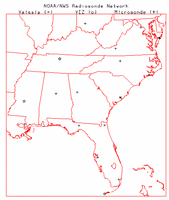 |
| |
|
| NOAA/NWS Radiosonde Network High Vertical Resolution Data - The same
radiosonde locations mentioned in the previous data set also provide a 6-second vertical
resolution data set that provides observations of pressure, temperature, altitude,
relative humidity, and azimuth and elevation angles. UCAR/JOSS has developed software
to derive 6-second vertical resolution winds from the angle data. These data are
archived by NCDC and UCAR/JOSS. |
 |
| |
|
| Cooperative Agency Profiler (CAP) Network - The NOAA/FSL ingests data
from wind profilers and RASS operated by a number of cooperating agencies. Most of
these profilers are 915 MHz, but some are 449 or 50 MHz. Most provide hourly observations
of wind speed and direction. The number and location of these can vary through time. As
this is being written the network included 58 locations within the US (1 in Maryland).
Most of the sites are along the US West Coast and in the northeastern US. For further
information visit the CAP home page at:
http://www.profiler.noaa.gov/jsp/aboutCap.jsp. |
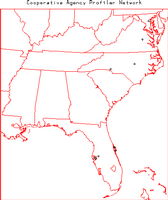 |
| |
|
| Ground Based Global Positioning System (GPS) Meteorology Demonstration Network
(GPS-MET) - The NOAA/FSL ingests data from 323 GPS locations around the US
operated by many different agencies (5 in Maryland). Typically each location provides
30-minute observations of integrated precipitatable water along with a number of surface
meteorology parameters (air temperature, relative humidity, barometric pressure, etc).
For further information visit the
GPS-MET home page. |
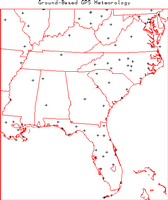 |
| |
|
| Aerosol Networks |
| |
|
| Aerosol Robotic Network (AERONET) - AERONET is an optical ground-based aerosol
monitoring network and data archive supported by NASA's Earth Observing System. The network
hardware consists of identical automatic sun-sky scanning spectral radiometers owned by national
agencies and universities. Data from this collaboration provides globally distributed (3 in Maryland)
near real time observations of aerosol spectral optical depths, aerosol size distributions and precipitable
water. For further information visit the
AERONET home page. |
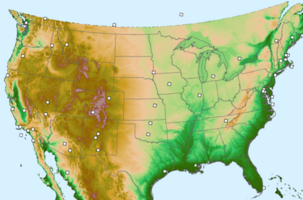 |
| |
|
| Regional East Atmospheric Lidar Mesonet - The Regional East Atmospheric Lidar Mesonet
(REALM) is a proposal by a number of lidar researchers and is designed to monitor air quality in the
vertical from multiple locations on the east coast. For further information visit the
REALM web site. |
Map at web site. |
| |
|
| Micro-Pulse Lidar Network (MPLNET) - MPLNET is comprised of ground-based lidar systems
that are co-located with sun/sky photometer sites in the NASA AERONET. Basic data from the MPL include
aerosol and cloud layer heights. The primary purpose of MPLNET is to acquire long-term observations of
aerosol and cloud vertical structure at sites around the world (1 in Maryland). For further information
visit the MPLNET home page. |
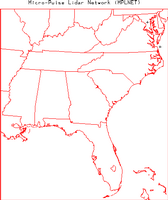 |
| |
|
| Coastal Networks |
| |
|
| Coastal-Marine Automated Network (C-MAN) -
The National Data Buoy Center (NDBC) operates this network of 55 C-MAN stations
with locations along coastlines throughout the US (1 in Maryland). The network
typically provides hourly observations of air temperature, barometric pressure,
wind speed, wind direction, and wind gust. Some stations also provide
observations of sea water temperature, water level, waves, relative humidity,
precipitation, and visibility. For further information visit the
NDBC home page. |
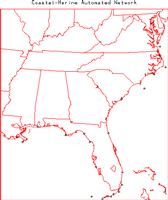 |
| |
|
| Physical Oceanographic Real-Time System (PORTS)
- The National Ocean Service (NOS) operates this network of 51 weather stations with
locations within bays and harbors along the Atlantic and Gulf of Mexico coastlines
(2 in Maryland). The network provides 15-minute observations of air temperature,
wind speed, wind direction, barometric pressure, water temperature, and water level.
For further information visit the
PORTS home page
. |
 |







































